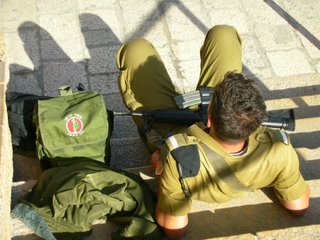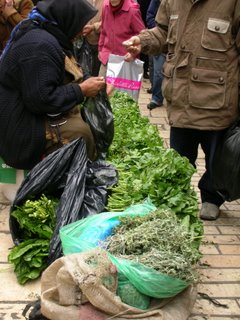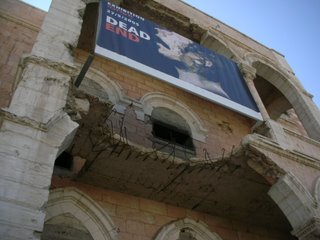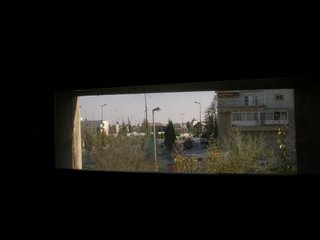Dignity in Difference
The differences between East and West Jerusalem are stark. West, Jewish, Jerusalem is not unlike the cities that we know. It is very much a Western city with an order and sensibility that is familiar. People dress and look like people on the streets of Toronto.
Unlike what we are used to, however, is the presence of security forces. They are omnipresent and visible. Police and military vehicles patrol the streets. Most every shop and restaurant has a guard at the door armed with a metal detector. All bags are checked before you enter. One gets used to standing in line for a bus or a coffee, the semi- automatic weapon of the soldier, usually just a kid, in front of you bumping into your nose. Teenagers who should be text messaging and preparing for tonight's party are instead in brown fatigues, back pack slung over their shoulder along with their automatic weapon. Military service is mandatory.
One gets used to standing in line for a bus or a coffee, the semi- automatic weapon of the soldier, usually just a kid, in front of you bumping into your nose. Teenagers who should be text messaging and preparing for tonight's party are instead in brown fatigues, back pack slung over their shoulder along with their automatic weapon. Military service is mandatory.
In East, Arab, Jerusalem it is different. Largely the buildings are older and in poor repair, evidence of a depressed economy and a repressed people. Trade commonly takes place right on the street. At Nablus Road and Sultan Suleiman goods are piled right on the sidewalk.
evidence of a depressed economy and a repressed people. Trade commonly takes place right on the street. At Nablus Road and Sultan Suleiman goods are piled right on the sidewalk. Streets are crowded, sidewalks narrow, cars in rough condition. There is a weariness and a wariness about the people.
Streets are crowded, sidewalks narrow, cars in rough condition. There is a weariness and a wariness about the people.
Here the military presence is not teenagers lining up for coffee with guns and backpacks slung over their shoulders, it is armored vehicles, often with the side door open and older, hardened, heavily armed soldiers glaring as they scan the streets. In West Jerusalem the feeling is that one is “being protected”. In East Jerusalem the feeling is more that one is the aggressor being controlled and “protected from”. A spirit of defiance hangs heavy in the air, especially among the women and the teenagers. Anger seems close to the surface, even as you sense an enormous leavening of patience.
“The Seam” is the dividing line between East and West. Historically it has been the seam between the old city and the new, between east and west, between religious and secular neighbourhoods.
The Museum on the Seam "link" is in Tourjemon House which was once a battle post on the front line, still scarred by bullet and mortar damage. It would become a centre for peace and tolerance. The Museum continues this mission with contemporary art exhibits that deal with different aspects of the socio-political realities of an increasingly pluralistic world in increasingly complex times.
The current show, Dead End, explores the deadly reality that turns violence into the language of every day life, threatening the very existence of human society.
The images displayed are stark. At times they are shockingly disgusting. The caption under one photograph of Palestinian children in a refugee camp reads: “What do you want to be IF you grow up?” Strangely, the images are not discouraging or depressing. As the text for the exhibit reads, the emphasis is upon "the red lines we have traversed, the borders we have crossed and calls on all of us to become involved and committed in mending our path.”
Strangely, the images are not discouraging or depressing. As the text for the exhibit reads, the emphasis is upon "the red lines we have traversed, the borders we have crossed and calls on all of us to become involved and committed in mending our path.”
It is a powerful and positive challenge for this international week of church action for peace in Palestine and Israel. It offers strong motivation to find ways to soften the lines of division that are so stark between East and West. It is a compelling call to all of us to move beyond existing separately, as we so often do in Toronto, as the “Curtain” Israel is constructing to divide it from the portions of the West Bank that it doesn’t want is intended to accomplish, to living within “healthy and proper society . . . based on mutual compromise and mutual respect and tolerance . . . upon the free exchange of opinions even if this opinion offends some.”
I think it was Friedrich Schleiermacher, an eighteenth century Reformed minister and founder of our modern theological thought, who first developed the idea that all thought, and even religious thought, originates in our experience, the context of our origins. Conditioning.
The challenge for us is to allow the “other” to be “other”, not needing them to become “us”. To do otherwise is to do violence to them.
To do otherwise is to do violence to them.
Jonathan Sacks, Chief Rabbi of the United Hebrew Congre- gations of Britain and the Common- wealth, in his book The Dignity of Difference, comes to the same conclusion. Our dignity is in our difference, not in our lowest common denominator of commonality.
What are your thoughts and reflections? How can we meet the challenge of living respectfully with our differences, whether in Toronto, Adelaide, southern Alberta, Texas, Nova Scotia or Jerusalem?
Unlike what we are used to, however, is the presence of security forces. They are omnipresent and visible. Police and military vehicles patrol the streets. Most every shop and restaurant has a guard at the door armed with a metal detector. All bags are checked before you enter.
 One gets used to standing in line for a bus or a coffee, the semi- automatic weapon of the soldier, usually just a kid, in front of you bumping into your nose. Teenagers who should be text messaging and preparing for tonight's party are instead in brown fatigues, back pack slung over their shoulder along with their automatic weapon. Military service is mandatory.
One gets used to standing in line for a bus or a coffee, the semi- automatic weapon of the soldier, usually just a kid, in front of you bumping into your nose. Teenagers who should be text messaging and preparing for tonight's party are instead in brown fatigues, back pack slung over their shoulder along with their automatic weapon. Military service is mandatory.In East, Arab, Jerusalem it is different. Largely the buildings are older and in poor repair,
 evidence of a depressed economy and a repressed people. Trade commonly takes place right on the street. At Nablus Road and Sultan Suleiman goods are piled right on the sidewalk.
evidence of a depressed economy and a repressed people. Trade commonly takes place right on the street. At Nablus Road and Sultan Suleiman goods are piled right on the sidewalk. Streets are crowded, sidewalks narrow, cars in rough condition. There is a weariness and a wariness about the people.
Streets are crowded, sidewalks narrow, cars in rough condition. There is a weariness and a wariness about the people. Here the military presence is not teenagers lining up for coffee with guns and backpacks slung over their shoulders, it is armored vehicles, often with the side door open and older, hardened, heavily armed soldiers glaring as they scan the streets. In West Jerusalem the feeling is that one is “being protected”. In East Jerusalem the feeling is more that one is the aggressor being controlled and “protected from”. A spirit of defiance hangs heavy in the air, especially among the women and the teenagers. Anger seems close to the surface, even as you sense an enormous leavening of patience.
“The Seam” is the dividing line between East and West. Historically it has been the seam between the old city and the new, between east and west, between religious and secular neighbourhoods.

The Museum on the Seam "link" is in Tourjemon House which was once a battle post on the front line, still scarred by bullet and mortar damage. It would become a centre for peace and tolerance. The Museum continues this mission with contemporary art exhibits that deal with different aspects of the socio-political realities of an increasingly pluralistic world in increasingly complex times.

The current show, Dead End, explores the deadly reality that turns violence into the language of every day life, threatening the very existence of human society.
The images displayed are stark. At times they are shockingly disgusting. The caption under one photograph of Palestinian children in a refugee camp reads: “What do you want to be IF you grow up?”
 Strangely, the images are not discouraging or depressing. As the text for the exhibit reads, the emphasis is upon "the red lines we have traversed, the borders we have crossed and calls on all of us to become involved and committed in mending our path.”
Strangely, the images are not discouraging or depressing. As the text for the exhibit reads, the emphasis is upon "the red lines we have traversed, the borders we have crossed and calls on all of us to become involved and committed in mending our path.” It is a powerful and positive challenge for this international week of church action for peace in Palestine and Israel. It offers strong motivation to find ways to soften the lines of division that are so stark between East and West. It is a compelling call to all of us to move beyond existing separately, as we so often do in Toronto, as the “Curtain” Israel is constructing to divide it from the portions of the West Bank that it doesn’t want is intended to accomplish, to living within “healthy and proper society . . . based on mutual compromise and mutual respect and tolerance . . . upon the free exchange of opinions even if this opinion offends some.”
I think it was Friedrich Schleiermacher, an eighteenth century Reformed minister and founder of our modern theological thought, who first developed the idea that all thought, and even religious thought, originates in our experience, the context of our origins. Conditioning.
The challenge for us is to allow the “other” to be “other”, not needing them to become “us”.
 To do otherwise is to do violence to them.
To do otherwise is to do violence to them. Jonathan Sacks, Chief Rabbi of the United Hebrew Congre- gations of Britain and the Common- wealth, in his book The Dignity of Difference, comes to the same conclusion. Our dignity is in our difference, not in our lowest common denominator of commonality.
What are your thoughts and reflections? How can we meet the challenge of living respectfully with our differences, whether in Toronto, Adelaide, southern Alberta, Texas, Nova Scotia or Jerusalem?


2 Comments:
Alan,
Thanks for the news from J. Today is very cold with a biting wind. I see it is much more temporate there. Stay well,
gg
Hello Alan;
I've been contemplating your challenge for a few days.
Your question fits well with Northrop Frye's comment that the good answers lead to better questions. This is a profound question that I need to think on more and more. Thank you Alan!
AB
Post a Comment
<< Home